2014 Campus RainWorks Challenge Winners
In 2014, sixty-four student teams from 23 states submitted green infrastructure designs for the third annual Campus RainWorks Challenge. Many of the designs proposed transformative additions to campus landscapes that would reduce stormwater impacts on water quality while providing educational and recreational opportunities. In April 2015, EPA announced four winners and two honorable mentions for the 2014 Campus RainWorks Challenge.
Congratulations to the Winning Teams!
First Place Winners
- University of Illinois at Chicago (Master Plan category)
- University of Maryland, College Park (Demonstration Project category)
Second Place Winners
- University of Illinois at Urbana-Champaign (Master Plan category)
- Queens College, City University of New York (Demonstration Project category)
Honorable Mentions
- University of Maryland, College Park (Master Plan category)
- Georgetown University (Demonstration Project category)
First Place Winner (Master Plan category): University of Illinois at Chicago
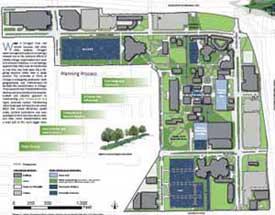 The design focused on the campus’s East Side, which has a large amount of impervious cover. To transform the campus to better manage stormwater and improve water quality, the team proposed a four-phased approach: 1) invest in demonstration projects; 2) expand successful projects based on monitoring data; 3) integrate green infrastructure projects and planning into campus management; and 4) transform the campus to unite natural hydrological and ecological functions with social and educational goals. The plan aims to not only help mitigate urban flooding in Chicago and provide educational and recreational opportunities on campus, but also demonstrate an adaptable planning process for implementing green infrastructure.
The design focused on the campus’s East Side, which has a large amount of impervious cover. To transform the campus to better manage stormwater and improve water quality, the team proposed a four-phased approach: 1) invest in demonstration projects; 2) expand successful projects based on monitoring data; 3) integrate green infrastructure projects and planning into campus management; and 4) transform the campus to unite natural hydrological and ecological functions with social and educational goals. The plan aims to not only help mitigate urban flooding in Chicago and provide educational and recreational opportunities on campus, but also demonstrate an adaptable planning process for implementing green infrastructure.
Project Narrative | Design Board 1 | Design Board 2
Student Team: Annie Cosgrove (Earth and Environmental sciences); Emmanuel Dominguez, Nicholas A. Haas, David Klawitter, Lisha Wu (Civil and Materials Engineering); Eduardo Munoz and Curtis Witek (Urban Planning Pnd policy).
Advisors: Ben O’Connor (Civil and Materials Engineering).
First Place Winner (Demonstration Project category): University of Maryland, College Park
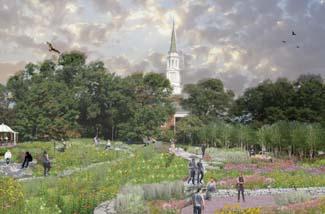 The design is centered on a seven-acre site next to the campus chapel. The plan seeks to capture and treat stormwater from adjacent parking lots and rooftops. The team proposes disconnecting storm pipes and replacing traditional lawn cover with a meadow landscape that includes bioretention, bioswales and rain gardens to treat 100 percent of a one-year storm event. The team’s design would provide habitat for pollinators and beneficial insect species, and would serve as an outdoor classroom and contemplative landscape for visitors and the university community.
The design is centered on a seven-acre site next to the campus chapel. The plan seeks to capture and treat stormwater from adjacent parking lots and rooftops. The team proposes disconnecting storm pipes and replacing traditional lawn cover with a meadow landscape that includes bioretention, bioswales and rain gardens to treat 100 percent of a one-year storm event. The team’s design would provide habitat for pollinators and beneficial insect species, and would serve as an outdoor classroom and contemplative landscape for visitors and the university community.
Project Narrative | Design Board 1 | Design Board 2
Student Team: Jonathan Gemmell, Penny Jacobs, Harris Trobman, Nick Yoder (Landscape Architecture); Jaison Renkenberger, and Yan Wang (Civil Engineering).
Advisors: Dr. Victoria Chanse, Mr. Dennis Nola, Dr. Lea Johnson, Dr. Peter May, Dr. David Myers (Faculty); and Karen Petroff (Facilities).
Second Place Winner (Master Plan category): University of Illinois at Urbana-Champaign
The design seeks to improve water quality of the highly channelized Boneyard Creek that runs through campus. As part of a larger planning framework to better manage stormwater on campus before it reaches the creek, the team’s plan extends the current network of green infrastructure through green streets, roof catchments, bioswales and rain gardens. In addition to upstream measures, the team’s plan proposes to transform the creek into a terraced, multifunctional landscape with native plantings, pollinator habitat and new recreational opportunities.
Project Narrative | Design Board 1 | Design Board 2
Student Team: Elizabeth Barr, Xinnan Jiang, Min Kang, Samantha Shui, Pongsakorn Suppakittpaisarn, John Whalen, Shurui Zhang, David Zhang (Landscape Architecture); Sarah Grajdura (Environmental Economics); Tianyu He, Fernanda Maciel (Civil Engineering), and Meri Mensa (Architecture).
Advisors: Tawab Hlimi (Landscape Architecture).
Second Place Winner (Demonstration Project category): Queens College, City University of New York
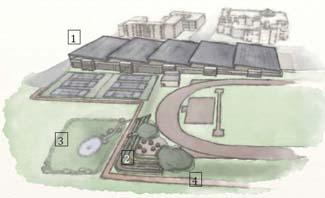 The team’s design proposes installation of a photovoltaic canopy and a rainwater harvesting system over a campus parking garage. This would direct runoff into vegetated terraces, a bioswale and a retention pond, resulting in infiltration and groundwater recharge. Annually the system is design to capture 3.75 million gallons of runoff and produce 1.4 gigawatt hours of electricity. It would reduce stormwater flow to the combined sewer system, mitigate concrete leaching and snow overloading on the parking structure, ensure electricity to campus buildings during natural disasters, and serve as a teaching laboratory for students.
The team’s design proposes installation of a photovoltaic canopy and a rainwater harvesting system over a campus parking garage. This would direct runoff into vegetated terraces, a bioswale and a retention pond, resulting in infiltration and groundwater recharge. Annually the system is design to capture 3.75 million gallons of runoff and produce 1.4 gigawatt hours of electricity. It would reduce stormwater flow to the combined sewer system, mitigate concrete leaching and snow overloading on the parking structure, ensure electricity to campus buildings during natural disasters, and serve as a teaching laboratory for students.
Project Narrative | Design Board 1 | Design Board 2
Student Team: Ebrahim Afshinnekoo, Stacy Chandisingh, Peter Ciavarella, Aislinn Deely, Colleen Frederick, Nick Kokkinos, Elissa Olivera, Gabriela Padewska, Chad Persaud, Chi Pang Yum (Environmental Science); Monika Brzostowska, Lili Ye (Environmental Studies); Alyssa Blumenthal (Environmental Engineering); and Sayashmini Madhow (Biology, Environmental Science).
Advisors: Dr. George R. Hendrey (Earth and Environmental Science)
Honorable Mention (Master Plan category): University of Maryland, College Park
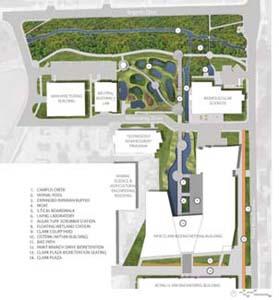 The team’s plan focuses on a 10-acre Innovation District in the northeast sector of campus which is occupied by agriculture, engineering, science, and technology uses and includes subwatersheds of the Anacostia River. To capture and treat stormwater, the plan incorporates several practices including floating wetlands, bioretention, expanded riparian buffers, and a cistern. The team’s plan would add an additional 2.4 acres receiving new pollutant treatment and reduce impervious cover by 16.8%. The plan not only reduces untreated stormwater and showcases innovative green infrastructure practices, but also has the potential to increase wildlife movement, enhance biodiversity, and engage students outside of the classroom through the creation of outdoor lab and research space.
The team’s plan focuses on a 10-acre Innovation District in the northeast sector of campus which is occupied by agriculture, engineering, science, and technology uses and includes subwatersheds of the Anacostia River. To capture and treat stormwater, the plan incorporates several practices including floating wetlands, bioretention, expanded riparian buffers, and a cistern. The team’s plan would add an additional 2.4 acres receiving new pollutant treatment and reduce impervious cover by 16.8%. The plan not only reduces untreated stormwater and showcases innovative green infrastructure practices, but also has the potential to increase wildlife movement, enhance biodiversity, and engage students outside of the classroom through the creation of outdoor lab and research space.
Student Team: Chris Shipley, Seth Fleming, Jun Jiang, Amina Mohamed (Landscape Architecture); Jaison Renkenberger, Yan Wang (Civil and Environmental Engineering); Maria Harwood (Sustainable Development and Conservation Biology); Benjamin Alexandro (Sustainable Development and Conservation Biology and Environmental Public Policy); and Monica Renee Saavoss (Agricultural and Resources Economics).
Advisors: Dr. Victoria Chanse (Plant Science and Landscape Architecture).
Honorable Mention (Demonstration Project category): Georgetown University
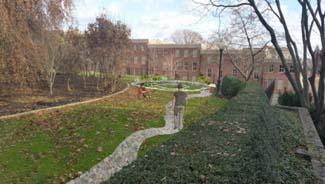 The design focuses on retrofitting areas around Lauinger Library, an iconic building on the university’s main quadrangle that receives an estimated 1 million visitors per year. The site comprises a significant portion of the sewershed and currently contains underutilized space, impermeable surfaces, and inefficient drainage. To mitigate stormwater runoff draining into the combined sewer, the team identified three mini-sites around the library to implement green infrastructure practices. The sites together have the potential to manage 22,050 gallons of rainwater during a 1.2” storm. The team’s design also improves community space on campus and provides opportunities for public education about sustainable stormwater infrastructure.
The design focuses on retrofitting areas around Lauinger Library, an iconic building on the university’s main quadrangle that receives an estimated 1 million visitors per year. The site comprises a significant portion of the sewershed and currently contains underutilized space, impermeable surfaces, and inefficient drainage. To mitigate stormwater runoff draining into the combined sewer, the team identified three mini-sites around the library to implement green infrastructure practices. The sites together have the potential to manage 22,050 gallons of rainwater during a 1.2” storm. The team’s design also improves community space on campus and provides opportunities for public education about sustainable stormwater infrastructure.
Student Team: Erin Leonard (Sustainable Development); Tyler Lopez (New Media and Politics); Sabrina Ma (Science, Technology, and International Affairs); Tess O’Connor (Media and the Environment); Andrew Postal (Media and Politics); Emily Rothkopf (Business Development); Liz Sabatiuk (Digital Media and Communications); and Eleri Syverson (Communication and Interaction).
Advisors: Dr. Evan Barba (Information and Communication Technologies) and Audrey Stewart (Sustainability, City and Regional Panning).
